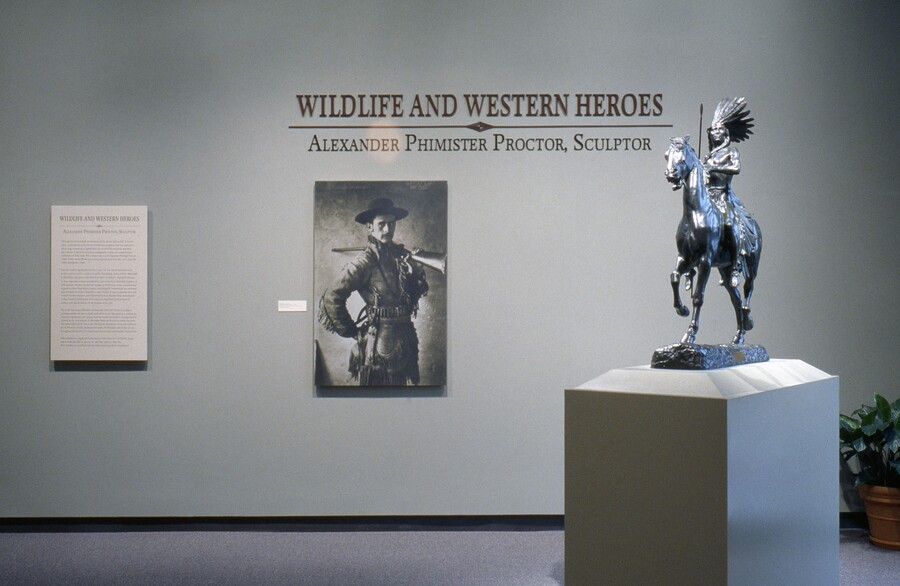September 15, 2003 Amon Carter Museum Presents Wildlife and Western Heroes: Alexander Phimister Proctor, Sculptor

Fort Worth, TX, September 15, 2003—On October 11, the Amon Carter Museum will present the first major exhibition of the work of Alexander Phimister Proctor (1860–1950), one of America's most prolific and successful sculptors of public monuments. Wildlife and Western Heroes: Alexander Phimister Proctor, Sculptor, which runs through February 1, 2004, will examine the life and work of this artist, a contemporary of Frederic Remington and Charles M. Russell.
Proctor's art celebrates both famous heroes and anonymous, iconic figures. Among his most famous works are General Robert E. Lee and Young Soldier in Dallas; Pioneer Mother on the campus of the University of Oregon; Broncho Buster and On the War Trail in Denver's Civic Center Plaza; and his magnificent Theodore Roosevelt in Portland, Ore.
Proctor's genius in depicting wild animals can be seen in the famous Tigers in front of Princeton University's Nassau Hall. His sculpture on various buildings in New York's Zoological Park (now the Bronx Zoo) portrays monkeys, elephants, rhinoceros, and frogs, all in a natural, yet lively style. His majestic Lions flank Pittsburgh's Frick Building, and four large Buffalo guard the expanse of the Q Street Bridge in Washington, D.C. His last great monumental commission, Mustangs, resides on the campus of the University of Texas at Austin.
"Although the field of study in American art has expanded significantly in recent years, many major American sculptors have yet to receive recognition," said Dr. Rick Stewart, director of the Amon Carter Museum. "This is especially true of Proctor, whose productive career spanned more than 50 years. In addition to his wonderful public monuments, he also produced some unforgettable smaller bronzes, many of which will be on view. They compare well with the finest work of Remington and Russell."
During his lifetime, Proctor was recognized as the acknowledged leader among American animaliers (sculptors of animal subjects) and as one of the country's foremost creators of public monuments based on western themes. He was the first sculptor in America to create monumental equestrian statues of both a Native American and of a cowboy, and his later public monuments include tributes to famous lawmen, circuit preachers, and pioneer women. Unlike Remington or Russell, Proctor received extensive training as a sculptor, and in the course of his career, he studied in Paris and Rome. In 1898 he won a gold medal at a Paris exposition, a unique feat for a young American artist. Proctor was a lifelong outdoorsman and hunter, and he insisted on using live animals as models for his work. In an effort to achieve a sense of naturalism and authenticity, he used champion bronc riders and famous Native American horsemen for his equestrian works. At the same time, Proctor brought a level of artistic refinement to his works that few sculptors of his time could match.
This exhibition consists of approximately 70 objects—small bronzes; models for monumental works; paintings, drawings, watercolors, and etchings; artist tools and other related artifacts; vintage photographs of the sculptor at work and his monuments in their actual locations; and works by other artists.
The exhibition is accompanied by the first in-depth scholarly publication of Proctor's work. The book was written by Peter H. Hassrick, founding director emeritus of the Charles M. Russell Center at the University of Oklahoma.
"Proctor carried with him through his long and rewarding life a contagious sense of joy and good humor," Hassrick said. "He was an artist who followed his creative muse to great accomplishments in the art of sculpture."
Rick Stewart pointed out that the exhibition owes its inception to the artist's grandson, Phimister Proctor "Sandy" Church, who has devoted his life to the investigation, collection, and appreciation of Alexander Phimister Proctor's art. Church founded the A. Phimister Proctor Museum near Seattle to showcase his grandfather's life and work. Proctor's youngest son, Gifford Proctor, who is now in his nineties and working as a sculptor in Connecticut, has also been involved in the preparation of the exhibition and publication.
A press preview for this exhibition will be held on Thursday, October 9. Both Sandy Church and Gifford Proctor will be in attendance.
The exhibition will travel to the Buffalo Bill Historical Center in Cody, Wyoming, in June of 2004.
Wildlife and Western Heroes: Alexander Phimister Proctor, Sculptor is organized by the Amon Carter Museum, Fort Worth, Texas, and is made possible in part by Mr. and Mrs. Sebert L. Pate, the Mary Potishman Lard Trust, and the Ruth and Vernon Taylor Foundation. The companion publication is generously supported by a gift from the Proctor Foundation, Poulsbo, Washington.
The Star-Telegram is the official print sponsor of the Amon Carter Museum.